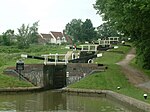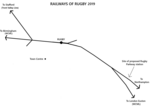Kilsby Tunnel

The Kilsby Tunnel is a railway tunnel on the West Coast Main Line in England, near the village of Kilsby in Northamptonshire, roughly 5 miles (8 km) southeast of Rugby. It is 2,423 yards (2,216 m) long. The Kilsby Tunnel was designed and engineered by Robert Stephenson for the London & Birmingham Railway (L&BR). It was constructed by contractors Joseph Nowell & Sons and later by the L&BR. It took much longer to construct and exceeded its estimated cost, attributed to a roof collapse and consequential flooding. At the time of its opening in 1838, it was the longest railway tunnel ever constructed.The tunnel had atypically large ventilation shafts, because of a lack of experience as to how much ventilation would be needed for steam locomotives to pass through. On opening in 1838, the tunnel was single track and in 1879, double-track was laid. In March 1987, Kilsby Tunnel portals and its two ventilation shafts were given listed status.
Excerpt from the Wikipedia article Kilsby Tunnel (License: CC BY-SA 3.0, Authors, Images).Kilsby Tunnel
Watling Street,
Geographical coordinates (GPS) Address Nearby Places Show on map
Geographical coordinates (GPS)
| Latitude | Longitude |
|---|---|
| N 52.331 ° | E -1.164 ° |
Address
Watling Street
Watling Street
CV23 8UW , Kilsby
England, United Kingdom
Open on Google Maps









